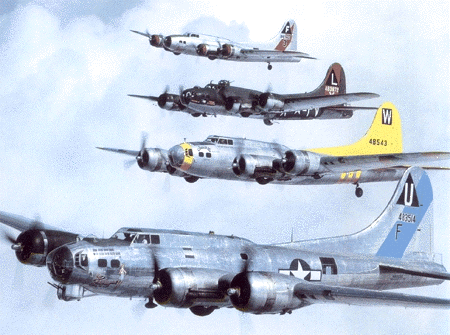
B-17
Documentaries and Videos
Contribute to the BGMA by
purchasing your videos through this site!

Roaring
Glory Warbirds - V.3: Flying B-17 Fortress
Pistol
Packing Mama: Mission of a B-17
B-17 Flying
Fortress
Memphis
Belle (1944)
Memphis
Belle (1990)
Flying the
Bombers B-17
91st Bomb Group Home  Photo History
Photo History
Crew Photos
 Specifications of the B17
Specifications of the B17
B-17
with a toilet? Thanks for the laugh. The nearest thing to a toilet was
the old relief tube that would freeze up at altitude with predictable
and often embarrassing results. Sam
Halpert
I
never saw a 17 with a chemical toilet but in the 322nd there was a spare
radio operator that I flew with several times that had to have a bowel
movement as soon as we got into the air. He used a steel helmet and
would set it on the fins of a bomb. Of course it stayed there till bombs
away, along with the odor. When it got into the oxygen system it seemed
to be worse. I used to say if some German was to find the helmet with
it's contents the would think they had blown some American's brains out.
Hank Hall
There
were toilets in the early B-17 models E and F. When the ground crew
obtained an aircraft they were told to remove the toilets at once.
There also was a Thermos jug and we were also told to remove them.
they really came in handy for a beer run to Duffy's Tavern. I never
did find out what was done with the toilets they removed. They may
have found their way into the portable johns they had at that time. Jack
Gaffney
|
History of the B-17 Flying Fortress
TThe Boeing B-17, perhaps the most famous of the World War
II combat aircraft, saw service in every combat theater. A total of 12,731
Fortresses were built.
In July 1941, the British used the B-17 on precision
bombing runs on enemy installations. In December of the same year, 17 Fortresses
flew the first U.S. missions in the Pacific. In August 1942, 12 B-17s made the first
U.S. raid from England, bombed Rouen, shot down their first German aircraft, and returned
with no casualties.
During the war, B-17s dropped 640,036 tons of bombs on
European targets in daylight raids. This compares with 452,508 tons dropped by
Liberators and 464,544 tons dropped by all other U.S. aircraft. The B-17s downed 23
enemy planes per 1,000 raid as compared with 11 by Liberators, 11 by fighters, and three
by all U.S. medium and light bombers.
Following 1935 when the first B-17 was built by Boeing,
constant design improvements developed the 32,000-pound Flying Fortress into the
65,000-pound giant of its day. During the later stages of the war, B-17s also were
built under license by Douglas and Lockheed.
(Above info compiled from the Confederate Air
Force brochure)
Cabin
Heating:
The
B-17F and G were equipped with receptacles to plug in flying
suits at all crew positions (the G model had an extra receptacle in the
radio room). There was also a cabin heating system. In
the B-17F and early G models this was a Glycol system that was heated by
the inboard engines.
Later
G models used a forced air system that heated the
air by running it through exchangers mounted on the engine exhaust
pipes - externally planes with the forced air system could be identified
by the metal covers over the exhaust pipes - this system also served to
defrost the windows.
Insulation:
There
was soundproofing insulation in the forward areas of the aircraft.
The flight deck was always insulated -in the B-17E,F and
early G models the bombardier and radio areas were also insulated.
In later G models it looks like the insulation was not installed in
the radio room or nose area - except for the bulkhead (forward of the
instrument panel).
Michael
Lombardi
Corporate Historian,
The Boeing Company
|
|
